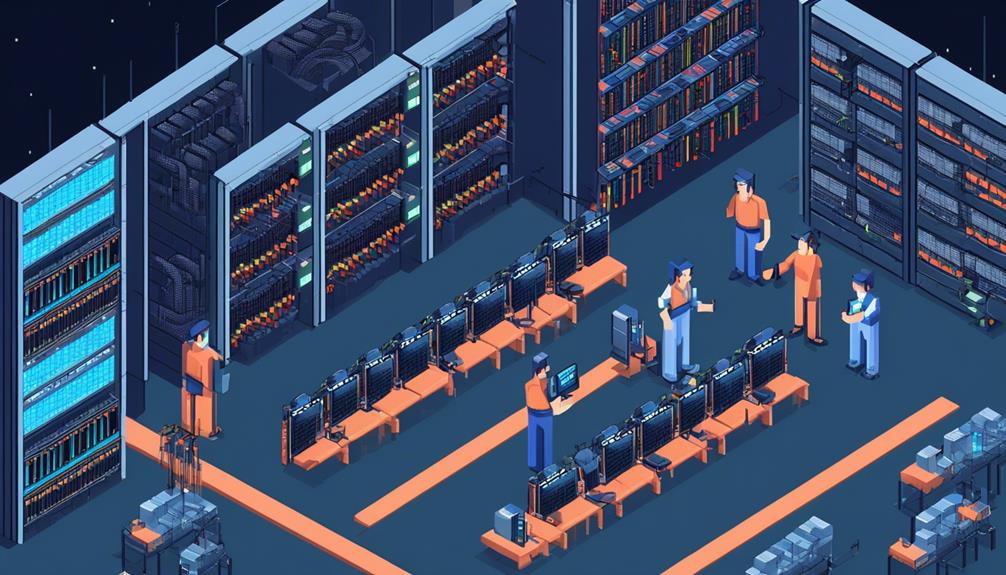Data center design is a critical aspect of establishing a robust and efficient IT infrastructure. From ensuring sufficient space to implementing reliable power and cooling systems, every element plays a crucial role in maintaining optimal performance and minimizing downtime.
In this discussion, we will explore the basics of data center design, including the purpose of data centers, the evolution of design practices, different types of data centers, and the factors that influence their design.
We will also delve into topics such as layout and construction, server and rack configurations, power and cooling solutions, data storage systems, and network infrastructure.
By understanding these fundamental concepts, you will gain valuable insights into the intricate world of data center design and discover how it can support your organization's technology needs.
Key Takeaways
- Data centers are purpose-built facilities that provide a secure and controlled environment for storing and processing large volumes of data.
- Design trends in data centers focus on sustainability, energy efficiency, and flexibility, with modular and scalable infrastructure solutions being adopted.
- Data center design and layout considerations include factors such as geographical stability, proximity to network connectivity hubs, scalability plans, environmental considerations, and compliance standards.
- Energy efficiency plays a crucial role in data center design, with strategies like server virtualization, efficient cooling systems, and power management contributing to reduced environmental impact and operational costs.
Purpose of Data Centers
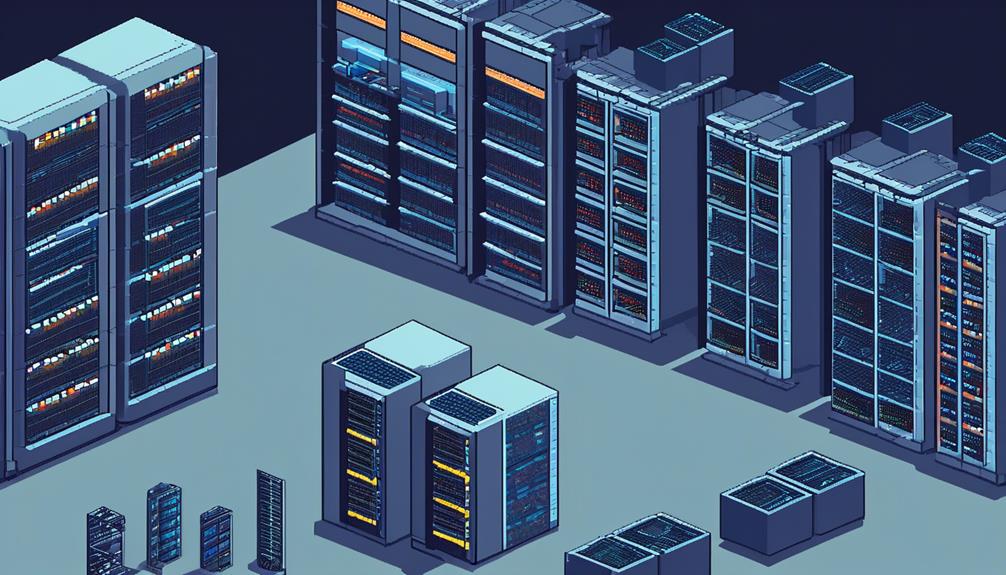
Data centers serve as critical infrastructure for organizations, providing a secure and controlled environment to house and manage their IT infrastructure and applications. These purpose-built facilities are designed to support the high availability, reliability, and performance of IT services and resources.
One of the key purposes of a data center is to provide a central location for organizations to store and process large volumes of data. With the increasing reliance on digital operations and the exponential growth of data, data centers offer the necessary physical space and infrastructure to accommodate the storage and processing requirements of businesses.
Data centers also play a crucial role in ensuring the security of data and applications. They are designed with multiple layers of security measures, including physical security controls such as access controls, surveillance systems, and biometric authentication, as well as network security controls such as firewalls and intrusion detection systems.
Additionally, data centers are equipped with robust power and cooling systems to ensure the continuous operation of IT infrastructure. These systems are designed to handle high-density computing equipment and to provide redundant power and cooling to prevent any disruption to the services.
Furthermore, data centers provide a reliable and high-speed network infrastructure to enable connectivity between various systems and applications. This facilitates efficient data transfer and communication within the data center environment.
To optimize the functionality and efficiency of data centers, best practices are followed in their design and operation. These include implementing modular design principles, using energy-efficient equipment, and adopting effective management and monitoring systems.
Evolution of Data Center Design
The evolution of data center design has brought about various design trends and challenges.
Design trends include a focus on sustainability, energy efficiency, and flexibility, as well as the incorporation of modular and scalable infrastructure solutions.
On the other hand, challenges in data center design encompass security, compliance, and resilience considerations.
These trends and challenges have been influenced by advancements in technology, such as cloud computing and virtualization, leading to more agile and dynamic data center architectures.
Design Trends in Data Centers
Design trends in the evolution of data center design prioritize energy efficiency, sustainability, and the reduction of carbon emissions. To achieve these goals, data center designers are implementing various strategies and technologies. The following table highlights some of the key design trends in data centers:
| Design Trends | Description | Benefits |
|---|---|---|
| Converged and Hyper-converged Infrastructure | Streamlines infrastructure management | Increased efficiency |
| Modular Builds and Cable Organization | Facilitates seamless scaling and longevity of cabling systems | Improved connectivity and maintenance |
| Cooling System Solutions | Addresses heat's impact on equipment lifespan | Enhanced equipment performance |
| Collaboration Space and Interdisciplinary Staff | Promotes efficient data center support and migration | Improved communication and problem-solving |
| Quick Response to Outages | Ensures reliable power supply and data continuity | Minimizes downtime and data loss |
| Disaster Recovery and Security Measures | Protects data center environment and safeguards against threats | Mitigates risks and ensures data integrity |
These design trends are aimed at creating data centers that are not only efficient and sustainable but also provide reliable and secure operations. By implementing these trends, organizations can optimize their data center infrastructure management and ensure the smooth operation of their critical IT systems.
Challenges in Data Center Design
As data center design evolves to prioritize energy efficiency and sustainability, it brings along various challenges that need to be addressed. These challenges include:
- Space management: With the increasing density of IT equipment, data center designers must find innovative ways to optimize the use of available space while ensuring proper airflow and cooling.
- Power usage effectiveness: As IT equipment becomes more power-hungry, data center design must focus on maximizing energy efficiency and reducing power consumption to minimize operational costs and environmental impact.
- Security protocols: With evolving threats and changing regulatory standards, data center design must incorporate robust security measures to protect sensitive data and ensure compliance.
To overcome these challenges, data center designers need to consider factors such as physical infrastructure, cooling systems, network design, data storage, power distribution, and information security.
Types of Data Centers
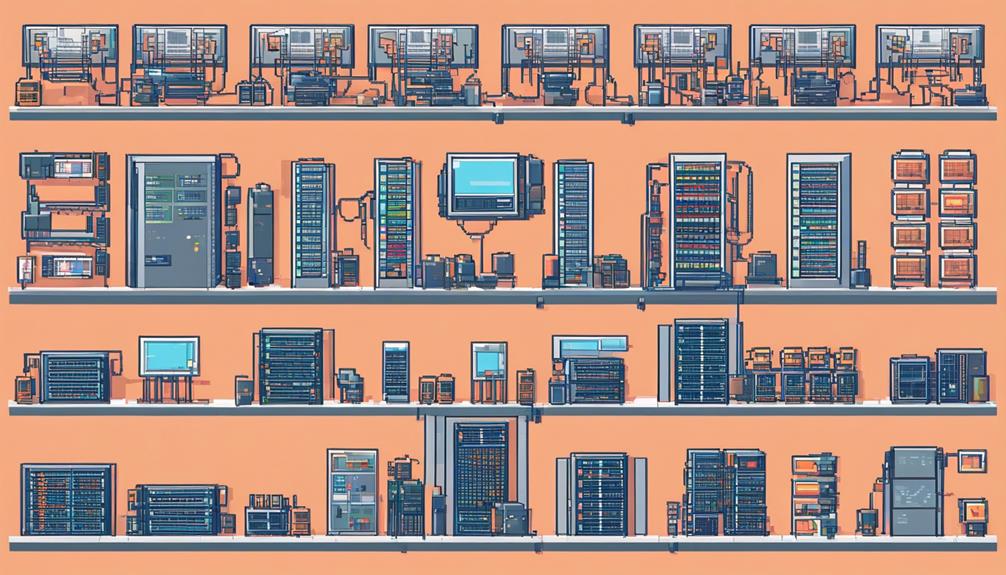
When discussing the types of data centers, it is essential to consider the key points of tier classification, modular design, and energy efficiency.
Tier classification refers to the standardized system that categorizes data centers based on their reliability and availability.
Modular design focuses on the scalability and flexibility of data centers, allowing for easier expansion or modification of infrastructure.
Lastly, energy efficiency is a crucial aspect in data center design, as it aims to minimize power consumption and reduce environmental impact.
Understanding these points is fundamental in designing and optimizing data centers for various requirements and objectives.
Tier Classification
The Tier Classification system is a widely recognized and utilized method for categorizing data centers based on their levels of redundancy and reliability. Understanding the tier classification is essential for designing data centers that meet specific business needs and uptime requirements.
Here are three key aspects of the tier classification system:
- Infrastructure: Tier I data centers have basic infrastructure, while Tier IV data centers are designed for fault tolerance and redundancy. The higher the tier, the more reliable and resilient the data center.
- Resilience: The tier classification helps in assessing a data center's resilience and its ability to withstand disruptions. Higher tier data centers are designed to minimize downtime and ensure continuous operations.
- Efficiency: Modern data centers typically use center infrastructure management (DCIM) to achieve efficient use of space, power, and equipment. Power usage effectiveness (PUE) is also an important metric for evaluating the energy efficiency of a data center.
Modular Design
Modular design revolutionizes the construction and adaptability of data centers by allowing for the seamless addition or removal of data center modules as needed. This approach offers flexibility and scalability, making it easier to adapt to changing IT infrastructure needs. Modular data centers can be used to quickly expand capacity or create specialized environments, such as edge data centers. There are different types of modular data centers, including containerized modules and skid-mounted modules. These prefabricated modules are built off-site and then installed within the data center facility.
To demonstrate the benefits of modular design, consider the following table:
| Types of Modular Data Centers | Description | Advantages |
|---|---|---|
| Containerized Modules | These modules are housed in shipping containers. They can be easily transported and deployed in various locations. | – Quick deployment<br>- Scalability<br>- Simplified maintenance |
| Skid-mounted Modules | These modules are pre-assembled on a skid and can be transported to the desired location. They offer flexibility in terms of capacity and design. | – Easy transportation<br>- Flexibility<br>- Cost-effective |
Modular design provides a cost-effective and efficient solution for designing a data center network. By utilizing modular data center modules, organizations can meet the demands of a robust data center while ensuring optimal data center cooling and scalability.
Energy Efficiency
Continuing the exploration of data center design, the focus now shifts to energy efficiency in different types of data centers. Here are the key considerations for energy efficiency in data centers:
- Enterprise Data Centers: These data centers optimize energy efficiency through server virtualization, efficient cooling systems, and power management strategies. They prioritize server consolidation and utilize hot and cold air containment to minimize energy waste.
- Cloud Data Centers: Energy efficiency in cloud data centers is achieved through economies of scale, efficient hardware utilization, and sourcing renewable energy. These data centers focus on maximizing hardware efficiency and reducing power consumption through advanced cooling techniques.
- Edge Data Centers: Edge data centers leverage localized computing resources and optimize power utilization for distributed infrastructure. These data centers prioritize energy efficiency by minimizing power loss during transmission and utilizing energy-efficient hardware.
Energy efficiency in data centers is a crucial aspect to reduce environmental impact and operational costs. By adopting technologies like liquid cooling, airflow optimization, and energy-efficient hardware, data centers can strive for power efficiency while still meeting the demands of the digital age.
Factors Affecting Data Center Design
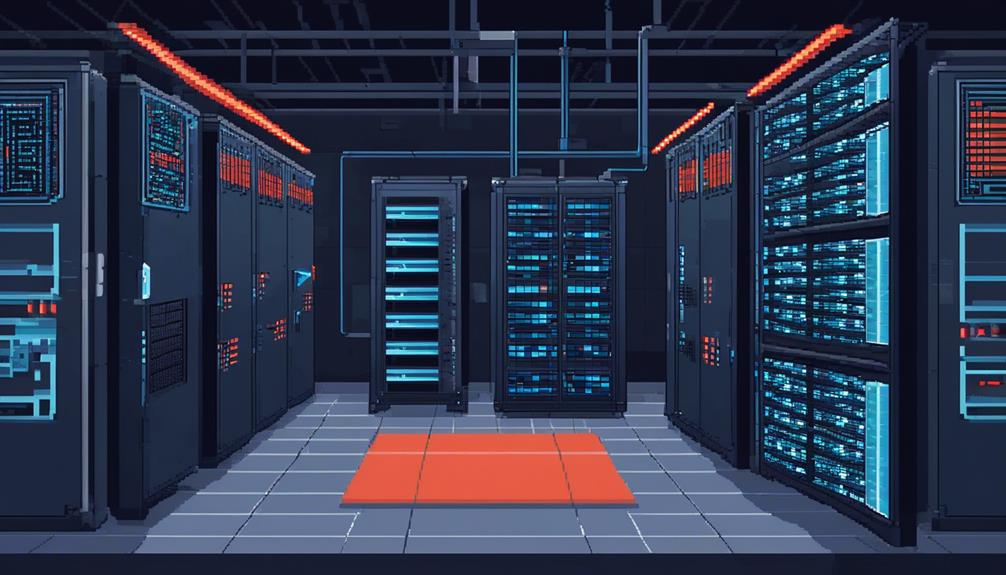
Factors impacting data center design include geographical stability, network connectivity proximity, scalability, environmental considerations, industry compliance, and power supply solutions.
When designing a data center, it is crucial to select a location that provides geographical stability, minimizing the risk of natural disasters such as earthquakes, floods, or hurricanes. Additionally, proximity to network connectivity hubs ensures fast and reliable communication paths between the data center and other network infrastructure.
Scalability is another important factor to consider in data center design. It is essential to plan for future growth and expansion to accommodate increasing data storage and processing needs. This includes designing a flexible data center layout that allows for easy reconfiguration of server racks and equipment as the business demands change.
Environmental considerations play a significant role in data center design, particularly in determining the cooling system. Cooling units, such as hot aisle/cold aisle configurations, are employed to maintain optimal temperature and humidity levels for the servers and other equipment. The choice of cooling system should take into account the local climate and weather patterns to ensure efficient and cost-effective operation.
Industry compliance is another factor that affects data center design. Regulatory standards and certifications, such as HIPAA and ISO, must be met to ensure the security and privacy of data stored in the data center. This may involve implementing specific security measures, access controls, and data protection protocols.
Lastly, power supply solutions are critical in data center design. Backup power sources, such as uninterruptible power supply (UPS) systems and generators, are essential to prevent data loss and downtime in case of a power outage. Additionally, considering environmentally friendly power solutions, such as renewable energy sources, can contribute to the overall sustainability of the data center.
Layout and Construction of Data Centers
Efficient layout and construction are essential components of a well-designed data center facility. The layout of a data center should optimize the arrangement of infrastructure components within the facility to ensure smooth operations and maximum efficiency. Adequate space planning is crucial to accommodate current and future IT infrastructure needs, allowing for scalability and growth. When it comes to construction, building requirements should ensure compliance with standards and regulations to guarantee the safety and security of the data center.
To further illustrate the importance of layout and construction in data centers, here are three key considerations:
- Data Center Security: Physical security measures must be implemented to protect the sensitive data housed within the facility. This includes controlled access systems, surveillance cameras, biometric authentication, and secure server rooms.
- Power Failure Preparedness: Data centers require a reliable power supply to ensure uninterrupted operations. Backup generators should be installed to provide emergency power in the event of a power outage, preventing data loss and downtime.
- Cooling and Airflow: Effective cooling and airflow management are crucial for maintaining optimal temperature levels within the data center. This prevents overheating of equipment and ensures the longevity and performance of servers and other hardware.
Servers and Racks in Data Centers
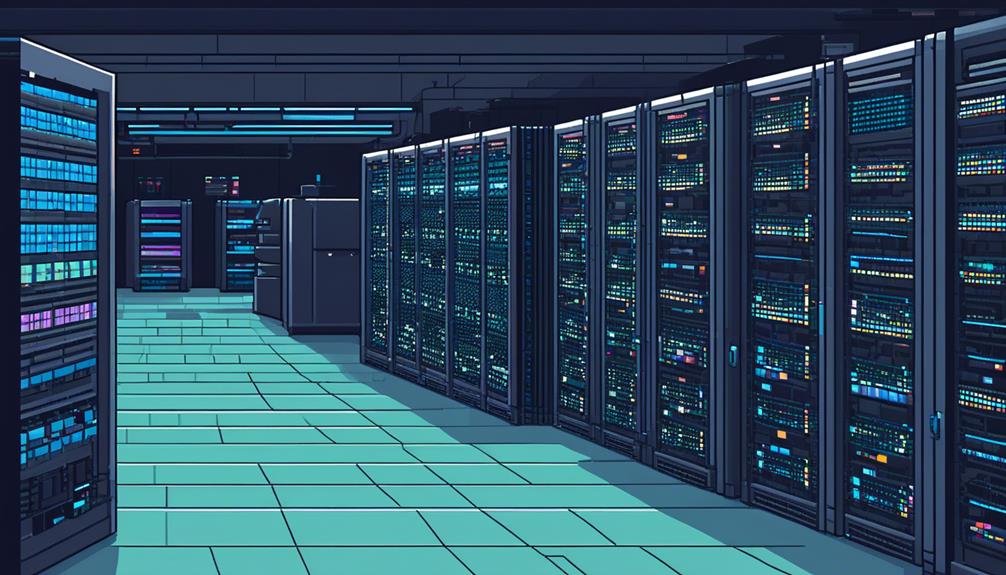
Servers and racks are integral components of data centers, serving as the backbone for hosting enterprise applications and organizing IT equipment within the facility. In data center design, the placement and arrangement of servers and racks are crucial for optimal operation and maintenance. Racks play a critical role in organizing and housing servers and IT equipment, ensuring efficient use of space. Proper cable management within racks is essential for interconnecting IT gear and maintaining organization in the data center.
Data center operators must consider physical barriers when designing the layout of servers and racks. These barriers help to separate different components and prevent unauthorized access. Additionally, cooling systems are essential to maintain an optimal operating temperature for servers. Heat distribution is a significant concern, and proper airflow management is crucial to prevent overheating and ensure the efficient functioning of servers.
Moreover, data center operators must prioritize data encryption to protect sensitive information. Encryption ensures that data remains secure during transmission and storage. This requires implementing robust security measures and protocols to safeguard servers and the data they host.
Power and Cooling Systems in Data Centers
Power and cooling systems are crucial components in data centers, ensuring the reliable and efficient operation of IT infrastructure. Here are three key points to consider when designing power and cooling systems for data centers:
- Reliable Power Supply:
Power systems in data centers must provide a continuous and reliable power supply to support the critical IT equipment. This involves the use of redundant power sources, such as uninterruptible power supplies (UPS) and backup generators, to mitigate the risk of power outages. Distribution units (PDUs) are used to distribute power to the racks and servers, ensuring proper power distribution and load balancing.
- Effective Cooling Solutions:
The heat generated by the IT infrastructure in data centers needs to be effectively managed and removed to maintain optimal performance and equipment longevity. Cooling systems, such as air conditioning units, are used to provide conditioned air to keep the data center environment at the required temperature. Hot air is expelled from the equipment and replaced with cooled air to maintain a suitable operating temperature.
- Scalability and Room for Growth:
When designing power and cooling systems for data centers, it is important to consider future growth and expansion. The systems should have the capacity to accommodate an increase in IT equipment and power requirements. This includes provisions for additional power distribution and cooling capacity, as well as space for new equipment.
Data Storage Systems in Data Centers
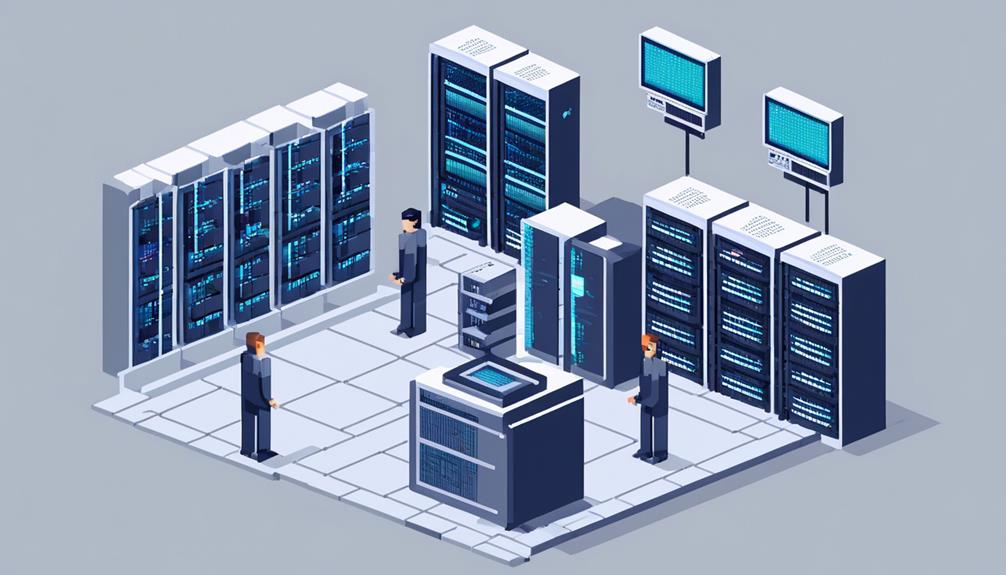
Data storage systems in data centers encompass a range of technologies used to store, organize, and protect application and business data within the data center infrastructure. These systems are essential for ensuring the availability, reliability, and performance of stored data for the entire IT environment.
There are various types of data storage systems used in data centers. Direct-attached storage (DAS) is a simple and cost-effective solution where storage devices are directly connected to servers. Network-attached storage (NAS) provides file-level storage and allows multiple servers to access the storage over a network. Storage area network (SAN) is a high-performance storage solution that provides block-level storage and is commonly used in enterprise environments. Object storage is a scalable and flexible storage solution designed for handling large amounts of unstructured data. Additionally, tape libraries and cloud storage offer long-term data retention options.
When choosing and implementing data storage systems, several factors need to be considered. Scalability is important to accommodate the growing amounts of data in a data center. Performance is crucial to meet the demands of applications and users. Data protection mechanisms, such as RAID (redundant array of independent disks), ensure the integrity and availability of data. Cost efficiency is also a significant consideration, especially when dealing with large-scale storage deployments.
Effective management and maintenance of data storage systems are vital to meet the evolving storage needs of the data center and its users. This includes monitoring storage capacity, optimizing data placement, implementing backup and disaster recovery strategies, and ensuring data center security.
Network Infrastructure in Data Centers
To ensure the seamless operation and protection of the data center infrastructure, a robust network infrastructure comprising switches, routers, firewalls, and other cybersecurity elements is essential.
Here are three key aspects of network infrastructure in data centers:
- Network Components: Data centers require switches, routers, and firewalls to create a business network. Switches facilitate communication between devices within the data center, while routers enable connectivity to external networks. Firewalls play a crucial role in data center security by monitoring and controlling incoming and outgoing network traffic. These components need to be carefully selected and configured to meet the specific requirements of the data center design.
- Network Cabling: Network infrastructure also encompasses the cabling used to interconnect the various components within the data center. Efficient cable management is crucial to ensure proper organization and maintenance of the network infrastructure. High-quality cables, such as fiber optic cables, are often used for their superior performance and scalability.
- Connectivity Considerations: The design of the network infrastructure should take into account connectivity to partners, carriers, and exchanges for optimal data center operations. Redundant network connections and diverse network paths are implemented to ensure high availability and minimize the risk of network downtime. Additionally, network capacity planning is essential to handle increasing data demands and future scalability.
Data center security and compliance are critical factors that must be considered when designing the network infrastructure. Robust security measures, including intrusion detection and prevention systems, encryption, and access control, are implemented to protect the integrity and confidentiality of data. Regular audits and compliance checks are carried out to ensure adherence to industry regulations and standards.
Frequently Asked Questions
What Are the Principles of Data Centre Design?
The principles of data center design encompass various factors to ensure optimal performance and reliability.
Scalability considerations allow for future growth and expansion.
Cooling strategies prevent overheating and maintain optimal temperatures.
Power distribution ensures a reliable and sufficient power supply.
Redundancy planning mitigates the risk of downtime.
Security measures protect valuable data.
Network infrastructure, rack and cabinet design, and cable management solutions optimize connectivity and organization.
Disaster recovery planning ensures business continuity.
Environmental sustainability incorporates renewable energy sources and efficient resource usage.
What Are the Basic Elements of a Data Center?
Data center infrastructure encompasses various components such as:
- Power management
- Cooling systems
- Network connectivity
- Storage solutions
- Security measures
- Disaster recovery plans
- Scalability options
- Monitoring and management tools
- Environmental considerations
These elements are essential for the smooth operation of a data center. Power management ensures a reliable power supply, while cooling systems regulate the temperature to prevent equipment overheating. Network connectivity ensures seamless communication, and storage solutions provide ample space for data storage. Security measures protect valuable data, and disaster recovery plans ensure business continuity. Scalability options allow for future expansion, while monitoring and management tools provide real-time oversight. Lastly, environmental considerations focus on energy efficiency and sustainability.
How Are Data Centers Designed?
Data centers are designed by considering various factors such as:
- Data center infrastructure
- Network architecture
- Cooling systems
- Power distribution
- Security measures
- Scalability options
- Redundancy strategies
- Equipment layout
- Fire suppression systems
- Environmental considerations
The design process involves:
- Conceptual design
- Layout planning
- Building construction requirements
- Physical security
- Operational workflows
To ensure efficient and reliable operations, data center design standards like:
- Uptime Institute Tier Standard
- ANSI/TIA 942-B
are followed. These standards provide guidelines for:
- Space requirements
- Equipment placement
- Power and cooling requirements
- Overall facility design.
What Are the Requirements for Data Center Design?
Data center design requirements encompass various aspects, including power efficiency, cooling systems, redundancy measures, scalability options, security protocols, network connectivity, rack and cabinet layout, cable management strategies, fire suppression systems, and environmental monitoring. These requirements ensure optimal performance, reliability, and safety of the data center.
Power efficiency measures help reduce energy consumption and operational costs. Effective cooling systems maintain the required temperature and humidity levels. Redundancy measures minimize downtime and ensure uninterrupted operations. Scalability options allow for future expansion. Security protocols safeguard against unauthorized access. Network connectivity ensures seamless communication.
Rack and cabinet layout, along with cable management strategies, optimize space utilization and facilitate easy maintenance. Fire suppression systems and environmental monitoring protect against potential hazards and ensure a safe working environment.
